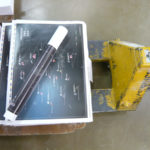Designing with LaTeX
Designing with TeX: episode I
 OSP is currently working on a book containing essays, interviews and images following from the Constant festival/seminar Tracks in electronic fields and we are laying it out in LaTeX!
OSP is currently working on a book containing essays, interviews and images following from the Constant festival/seminar Tracks in electronic fields and we are laying it out in LaTeX!
LaTeX is a tool developed in the context of academic publishing, specifically for technical or scientific documents. It combines markup à la CSS with powerful algorithms automatizing widow / orphan control and intelligent image placement.
We’ve grown more and more interested in LaTeX because it is specifically developed for typographically sane paper publications, and as far as you can get from regular canvas-based typesetting. We are also curious to experience from up close the sophisticated typographic system developed by Donald Knuth.

How will we be able to design with LaTeX? Will we need to change our workflow? Space for experiment and playing around? Can we use the design patterns built in to the tool, in another context? Will the book ‘look-and-feel’ like a scientific publication in the end?
There are several reasons to want to know the definitions of LaTeX commands: from the simplest “idle curiosity”, to the pressing need to patch something to make it “work the way you want it”. None of these are pure motives, but knowledge and expertise seldom arrive through the purest of motives.
http://www.tex.ac.uk/cgi-bin/texfaq2html?label=ltxcmds
Installing fonts in LaTEX has the name of being a very hard task to accomplish. But it is nothing more than following instructions. However, the problem is that, ?rst, the proper instructions have to be found and, second, the instructions then have to be read and understood.
http://www.ntg.nl/maps/29/13.pdf

Ivan and Pierre are the OSP’s to take the first plunge. Ivan has tetex installed on his Gentoo system, and Pierre texlive on Ubuntu. Getting the Belgian-French Azerty keyboard working was not easy, and also installing other fonts than the default took some time. But once done, they are quickly producing those typical academic standard publications from OpenOffice documents, though this time with quite a different kind of content.
The book is planned to come out before the end of this years so we will report back with more concrete design samples soon.





4 Comments ↓
1. Pierre
Oct 28, 2008 at 11:54 am
Don’t miss other TeX macros packages such as ConTeXt
or even other TeX implementations such as XeTeX
Can’t wait to see the result!
2. yosch
Oct 28, 2008 at 12:57 pm
I’d recommend you take a look at TeXworks:
http://www.tug.org/texworks/
There are slides and presentation videos worth watching.
It’s designed to lower the barrier to entry to the TeX world…
3. Ivan
Oct 31, 2008 at 10:16 am
that square with sides labeled f, g, p, q looks like a `pullback’ diagram. some algebraists and topologists would also call it a `fibred product’ 🙂
http://en.wikipedia.org/wiki/Pullback_(category_theory)
4. murfit
Nov 7, 2008 at 1:07 am
As Pierre already wrote, you should look into XeTeX because it makes font installing unnecessary. As for getting exactly the design you want, in my experience hacking into LaTeX can actually be more complicated than building it from scratch using plain TeX or expanded plain TeX. The nice thing about the pure TeX engine is that it just provides the basic typesetting facilities and makes very few assumptions about the layout you want to implement.